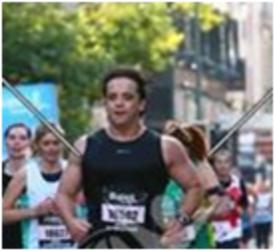So explain to me again why I can't use my HRM

Rae6503
Posts: 6,294 Member
while lifting? I wore it the other day when doing my New Rules routine. 15 reps each set, 60 seconds rest between. I was red-faced and breathing hard at the end of each set and hadn't completely caught my breath before starting again. It said i burned 300 calories in those 30 or so minutes. How far off is this from reality?
0
Replies
-
You're not supposed to? I'd never heard that. I'm curious to see the answers you get.0
-
I use mine and usually do between 250-350 cals during a 30-40 min session.0
-
I've never heard that either. I wear my HRM when I lift.0
-
I'm no expert, but I'd definitely log that burn if I were you!
I'll be interested to see the arguments against, if there are any.
I think it's difficult to figure out the calorie burn for strength training without an HRM - but with one, why not?0 -
Different activities burn different amounts of Calories at the same heart rate. What does your HRM manual say about it?0
-
I use mine when I lift, don't know why you wouldn't.0
-
I wear mine when I lift as well. Today I took a group power class. In 55 minutes I burned 339.0
-
I'm using it RIGHT NOW0
-
Absolutely you can and should use your HRM with any exercise!
 It's the only way to really know how much you're burning. You burn a lot more with cardio, but that doesn't mean you can't use it with weights.
It's the only way to really know how much you're burning. You burn a lot more with cardio, but that doesn't mean you can't use it with weights.
Go for it!0 -
I think I read something about the increase in blood pressure you experience from lifting makes the result wrong, but I don't remember for sure.0
-
i wear mine all the time at work and at any exercise
 0
0 -
It depends on the style of lifting that you are doing. If you are focusing on strength or power, your HRM is useless. But if you're doing resistance training as part of a circuit or in a cardio fashion, it should operate normally.0
-
The reason I can see for the "against using it" is that it will not give you an accurate burn, since you will keep burning after your session. (Depends a little on what type of lifting sure, but in general this is the case). So maybe its a recommendation to not use it because a HRM cannot accurately predict your "real" numbers.0
-
Also, HRMs are useless for everyday use. If you wear it all day long, you're not going to get accurate numbers.0
-
There is some research that it isn't necessarily as accurate for lifting as cardio, but with Polar introducing monitors that actually have specific functions to assist you in getting the most out of your weight sessions, I find it hard to believe it's not somewhat close.0
-
It depends on the style of lifting that you are doing. If you are focusing on strength or power, your HRM is useless.
But why?0 -
Do 1/2 your workout, then jump on the treadmill or a rower for about 2 minutes HARD. Then go back and finish the weights, you will be doing your body good and burn 1/3 more calories! Then finish back on the treadmill or rower HARD for another 2 minutes.0
-
There is some research that it isn't necessarily as accurate for lifting as cardio, but with Polar introducing monitors that actually have specific functions to assist you in getting the most out of your weight sessions, I find it hard to believe it's not somewhat close.
They must be expensive. I looked up the Polar F55 upon learning this and found that it costs $220. No thanks...0 -
If it motivate you....use it and count it! I find it very satisfying to log the cals burned. I don't always eat them back but I take credit for it!:happy:0
-
It depends on the style of lifting that you are doing. If you are focusing on strength or power, your HRM is useless.
But why?
I'm quoting a book on Heart Rate Monitor Training.
"Lifting weights causes increases in blood pressure, reduces breathing frequency, and requires large static muscle contractions. The result is a blunted heart rate response to an immediate bout of exercise."
Another thing that comes into play is VO2 max and your heart trying to keep up with an oxygen deficit in a short term exercise bout.0 -
Because most HRMs just use a simple calculation where it uses your heart rate, weight, height etc to work out how many calories you've burned. That's all it does - it has no idea of how much actual work you're doing. So after a set of lifting you may be panting and your heart rate may be high, but the only work you're actually doing is sitting on the bench waiting to do your next set. So it carries on thinking you're exercising as your heart rate is still high, but in reality you're not doing anything. That's why they work better for cardio - generally you ARE working muscles and burning calories for the whole time the HRM is measuring your heart rate.
But as has already been mentioned, if you do the sort of weight training where you have very few, short rests and you are constantly out of breath (circuit training and the like) then it can be more accurate, but it's still only a ball park figure.0 -
http://www.myfitnesspal.com/blog/Azdak/view/hrms-cannot-count-calories-during-strength-training-17698
This is a more complete answer to the questions.0 -
Ok, so if you were to move quickly between excercises would it be accurate then?0
This discussion has been closed.
Categories
- All Categories
- 1.4M Health, Wellness and Goals
- 398.2K Introduce Yourself
- 44.7K Getting Started
- 261K Health and Weight Loss
- 176.4K Food and Nutrition
- 47.7K Recipes
- 233K Fitness and Exercise
- 463 Sleep, Mindfulness and Overall Wellness
- 6.5K Goal: Maintaining Weight
- 8.7K Goal: Gaining Weight and Body Building
- 153.5K Motivation and Support
- 8.4K Challenges
- 1.4K Debate Club
- 96.5K Chit-Chat
- 2.6K Fun and Games
- 4.8K MyFitnessPal Information
- 13 News and Announcements
- 21 MyFitnessPal Academy
- 1.6K Feature Suggestions and Ideas
- 3.2K MyFitnessPal Tech Support Questions















